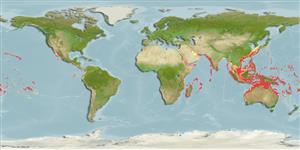>
Acanthuriformes (Surgeonfishes) >
Chaetodontidae (Butterflyfishes)
Etymology: Forcipiger: Latin, forceps = instrument of the pincers kind used for seizing and holding objects, esp. In surgical and obstetric operations + latin, gero = to carry; 1634 (Ref. 45335).
More on authors: Jordan & McGregor.
Issue
FishBase common name changed from Longnose butterfly[ ]fish FAO/ASFIS: Ref. 131312 ) to Forcepsfish (AFS: Ref. 130874) because it is used forForcipiger longirostris (and longirostris = long nose).
Environment: milieu / climate zone / depth range / distribution range
Ecologia
marino associati a barriera corallina; non migratori; distribuzione batimetrica 0 - 145 m (Ref. 89467). Tropical; 36°N - 32°S, 30°E - 79°W
Indo-Pacific: Red Sea and East Africa (Ref. 12484) to the Hawaiian and Easter islands, north to southern Japan, south to Lord Howe Island; throughout Micronesia. Eastern Pacific: southern Baja California, Mexico and from the Revillagigedo and Galapagos Islands (Ref. 5227, 11482).
Size / Peso / Age
Maturity: Lm ? range ? - ? cm
Max length : 22.0 cm TL maschio/sesso non determinato; (Ref. 9710); Età massima riportata: 18 anni (Ref. 72479)
Spine dorsali (totale) : 12 - 13; Raggi dorsali molli (totale) : 19 - 25; Spine anali: 3; Raggi anali molli: 17 - 19.
Common in exposed seaward reefs but also found in lagoon reefs (Ref. 9286). Benthopelagic (Ref. 58302). Solitary or in small groups of up to 5 individuals (Ref. 9286). Adults usually in pairs (Ref. 48636). Feed on a wide variety of animal prey including hydroids, fish eggs, small crustaceans but prefers tube feet of echinoderms, pedicilaria of sea urchins, and polychaete tentacles (Ref. 1602). Oviparous (Ref. 205), monogamous (Ref. 52884). Form pairs during breeding (Ref. 205). Second most important export in Hawaii (Ref. 37816). Minimum depth reported taken from Ref. 128797.
Life cycle and mating behavior
Maturità | Riproduzione | Deposizione | Uova | Fecundity | Larve
Distinct pairing (Ref. 205). Monogamous mating is observed as both obligate and social (Ref. 52884).
Myers, R.F., 1991. Micronesian reef fishes. Second Ed. Coral Graphics, Barrigada, Guam. 298 p. (Ref. 1602)
IUCN Red List Status (Ref. 130435: Version 2024-1)
Threat to humans
Harmless
Human uses
Pesca: di nessun interesse; Acquario: Commerciale
Strumenti
Special reports
Download XML
Fonti Internet
Estimates based on models
Preferred temperature (Ref.
123201): 24.3 - 28.8, mean 27.5 °C (based on 710 cells).
Phylogenetic diversity index (Ref.
82804): PD
50 = 0.6250 [Uniqueness, from 0.5 = low to 2.0 = high].
Bayesian length-weight: a=0.01995 (0.00906 - 0.04395), b=3.01 (2.83 - 3.19), in cm total length, based on all LWR estimates for this body shape (Ref.
93245).
Trophic level (Ref.
69278): 3.1 ±0.2 se; based on diet studies.
Resilienza (Ref.
120179): Alto, tempo minimo di raddoppiamento della popolazione meno di 15 mesi (Preliminary K or Fecundity.).
Fishing Vulnerability (Ref.
59153): Low vulnerability (12 of 100).
Nutrients (Ref.
124155): Calcium = 77.3 [40.2, 116.8] mg/100g; Iron = 0.735 [0.446, 1.180] mg/100g; Protein = 18.5 [17.4, 19.7] %; Omega3 = 0.129 [0.079, 0.208] g/100g; Selenium = 44.4 [24.8, 80.8] μg/100g; VitaminA = 44.4 [12.5, 154.3] μg/100g; Zinc = 1.25 [0.86, 1.79] mg/100g (wet weight);
